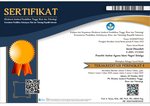The Derivational Processes of Coronavirus Related Terms in WHO Website "Mythbusters"
Abstract
The present research discusses about the derivational process of Coronavirus in WHO website “Mythbusters”. The reason of choosing the topic is because word formation processes occur in various area, including scientific areas. The impact of Coronavirus disease influenced the usage of spesific terms related with Coronavirus. People need to understand the Coronavirus related terms, so that they able to use and understand new terms to help them deliver different kinds of information. This research has the purpose of figuring out what types of derivational word formation of Coronavirus related terms are found in the WHO "Mythbusters." Thus, a morphological approach is used to facilitate the researcher on conducting the analysis. The researcher conducted a qualitative research using content analysis in analyzing the data. Based on the analysis of derivational processes in WHO website “Mythbusters” article, the researcher found 24 coronavirus related terms formed by derivational processes. There are 18 coronavirus related terms formed by derivation process, which consist of 10 nominalizer and 8 adjectivalizer found in the article. The derivational affixes occur in “Mythbusters” are {-ion}, {Anti-}, {-ness}, {-ment}, {-al}, {-ous}, {-ful}, and {-y}. There are 6 coronavirus related term formed by compound process. 5 terms are formed with compound noun process, while the other is formed by compound adjective.
Key words: Derivational, Coronavirus, WHO
Full Text:
PDFReferences
Brinton, L.G., & Brinton, D. M. (2010). The Linguistic Structure of Modern English. Amsterdam: John Benjamins Publishing.
Coronavirus. (n.d.). Retrieved from https://www.who.int/healthtopics/Coronavirus#tab=tab_1
Culpeper, J., Kerswill, P., Wodak, R., McEnery, T., & Katamba, F. (2018). English Language: Description, Variation and Context (2nd ed.). Basingstoke, Hampshire: Palgrave Macmillan.
Fatmawaty, R., & Anggraini, P. A. (2019). An Analysis Of English Word Formation Processes In Beats Apart Novel By Alanda Kariza And Kevin Aditya. Jurnal ELink, 6(1), 164-182. doi:10.30736/e-link.v6i1.125
Jones, L., Palumbo, D., & Brown, D. (2020, June 30). Coronavirus: A visual guide to the economic impact. Retrieved September 9, 2020, from https://www.bbc.com/news/business-51706225
Krippendorff, K. (2004). Content analysis: An introduction to its methodology. Newbury Park : Sage.
Montero-Fleta, B. (2011). Suffixes in Word-formation Processes in Scientific English. LSP Jourrnal, 2, 2nd ser., 4-14.
Moehkardi, R. R. (2017). Patterns and Meanings of English Words through Word Formation Processes of Acronyms, Clipping, Compound and Blending
Ratih, E., & Gusdian, R. I. (2018). Word Formation Processes In English New Words Of Oxford English Dictionary (Oed) Online. A Journal of Culture English Language Teaching Literature & Linguistics, 5(2), 24-35. doi:10.22219/celticumm.vol5.no2.24-35
DOI: https://doi.org/10.18326/dinamika.v2i1.1-20
Refbacks
- There are currently no refbacks.
Copyright (c) 2021 Brando Pancarian Butar
License URL: https://creativecommons.org/licenses/by-sa/4.0/









